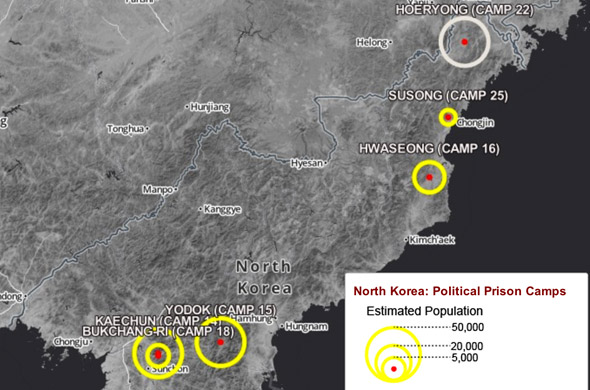This is the first of several postings of the North Korea Revealed blogging series, published in the context of efforts to establish a Commission of Inquiry at the current session of the UN Human Rights Council (February 25 – March 22). Join the conversation through #NKRevealed.
I was born in North Korea in 1982. I was born in a political prison camp (…) and lived there until I escaped in 2005 (…) I was born to an imprisoned mother and father. —Shin Dong-hyuk, the only known North Korean born in a political prison camp to have escaped.
Shin’s shocking story personifies the horrors of North Korea’s vast network of political prison camps, believed to house over a hundred thousand prisoners. His story is emblematic for the daily forced hard labor, calculated starvation and torture that prisoners have to endure. It also reflects the system of collective punishment that results in the incarceration of several generations of one family, often for life. You can hear more from Shin on a new video playlist, together with testimonies of other escapees and exiles. Their voices urge immediate action to stop the horrors of the prison camps.
I have put together this new video playlist with the help of our friends at WITNESS. We are publishing it—together with other materials such as a map and satellite images of the camps on Google Earth—ahead of the release of a new satellite image analysis later this week (check back on this blog). The materials explain the abysmal human rights situation—described by the UN as being in “its own category”—and give the context to our forthcoming findings.
The impossible playlist
The playlist also includes a shocking account of a former prison guard from Camp 22 and expert opinions. The Human Rights Channel that hosts the playlist normally presents citizen journalism to expose underreported human rights abuses—in the case of North Korea, an impossible task. North Korea regularly ranks near the top of lists of most censored countries. While some incredible citizen journalism from North Korea has started to emerge over the last year, we were barely able to locate any footage of the actual political prison camps. Having that said, I am curious if recent developments in North Korea will help to expand the country’s “digital underground.” The last week already saw the first Tweets and Instagram pics emerge from North Korea—of course, these mobile social media options are still limited to foreigners.
My hope is that the video testimonies and maps will help tell a story that go beyond the geopolitical focus people normally associate with North Korea. Looking beyond the nuclear issue is important, as the UN Human Rights Council is preparing for an important vote to establish an independent Commission of Inquiry on the widespread and systematic human rights violations in North Korea.
If you are as outraged about these stories and the political prison camps in North Korea as I am, please share these online materials as widely as possible. Governments currently represented at the Human Rights Council have to hear that people globally care about this issue.
Reveal North Korea’s secret
Many people and organizations—including Amnesty International—have to rely on satellite imagery to circumvent the rigid restrictions in and limited access to North Korea. In fact, using a free tool such as Google Earth puts the camps at every Internet user’s fingertips. I urge you to watch and share our teaser video and explore images of the camps for yourself by downloading our Google Earth layer.
Revealing and widely publicizing the camp system is the first step in countering the North Korean government’s outright denial of the existence of the camps. The more people know about their existence, the more difficult it will get for authorities to continue their denial. Shining a light on such abuses is at the core of Amnesty International’s work, originating in the appeal for amnesty for “The Forgotten Prisoners.” While in the 21st century we might rely on satellites, video and social media to shine that light on North Korea’s forgotten prisons, the power of collective action to unveil the most egregious abuses remains the key for positive change. I invite you to join me.

Wow! Thank-you for your incredible work in bringing this very dark information into the light.
thanks for the positive feedback, much appreciated!
thanks for this,,..